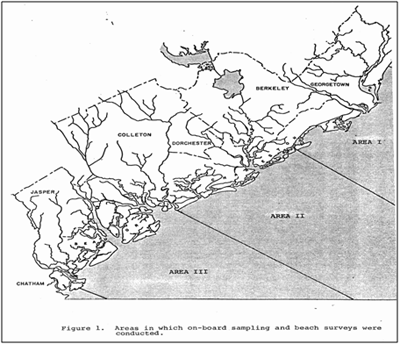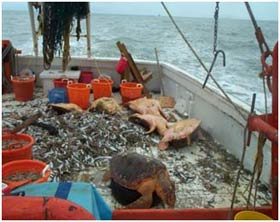Sea turtle catch rates
Observer surveys
Following the proposal by NMFS to list loggerhead sea turtles as a threatened species in 1975 and a survey of sea turtles stranding along the SC coast in the same year [9], SCDNR MRD observers were placed aboard selected commercial trawlers fishing for white and brown shrimp from the GA border through Georgetown, SC in 1976 and 1977 [10]. During 1,412.3 hours of observer coverage during commercial trawling between the months of June and October, 35 live and 17 dead loggerhead sea turtles were documented, which equates to an average of 25 (1977) to 29 (1976) hours to encounter a single loggerhead sea turtle.

Coastal regions off South Carolina where incidental catch of sea turtles in the commercial shrimp fishery was monitored during summer and fall in 1976 and 1977 (this image is Figure 1 in the Ulrich 1978 report).

A modern appreciation for what shrimp catches might look like without the requirement for Turtle Excluder Devices (TEDs). This image denotes six loggerhead sea turtles captured during a 30 minute tow (without TEDs) aboard the FV Winds of Fortune off Charleston, SC in summer 2000. Personnel from SCDNR collected blood samples and recorded data, after which all of these sea turtles were safely released overboard.
In June 2000, a second MRD observer program was initiated near Charleston, SC and Brunswick, GA. Trawl times were limited to 30 minutes and shrimp trawl nets were exempt from required use of Turtle Excluder Devices. Time to interact with a loggerhead sea turtle declined appreciably to 6.1 hours (10 loggerhead sea turtles in 61.5 hours of trawling) near Brunswick, GA and 2.0 hours (30 loggerhead sea turtles in 60.9 hours of trawling) near Charleston, SC. Reduced observer monitoring effort was completed near Charleston, SC in June 2001 to 2003 and revealed similar trends (18 loggerheads in 26.2 hours to 54 loggerheads in 27.6 hours).
Although exact spatial comparisons and study nuances such as trawling within channels vs. adjacent shoals and net sizes and numbers cannot be discounted, the dramatic decrease in the time required to interact with a loggerhead sea turtle was consistent with the suggestion of greater relative abundance in coastal waters in the Southeast U.S. [11] Most importantly, the findings of this observer program substantiate the value of requiring shrimp trawls to be equipped with TEDs since the early 1990s.
9 Ulrich, G.F. 1976. Status report on the Loggerhead turtle (Caretta caretta caretta) in South Carolina Waters Relevant to the Commercial Shrimp Trawler Fishery. Special Section Project, For Intra-departmental use only. 7p. plus Appendices.
10 Ulrich, G.F. 1978. Incidental catch of Loggerhead Turtles by South Carolina Commercial Fisheries. Report to National Marine Fisheries Service, Contract nos. 03-7-042-35151 and 03-7-042-35121, 36p. plus Appendices.
11 Maier, P.P., Segars, A.L., Arendt, M.D., Whitaker, J.D., Stender, B.W., Parker, L., Vendetti, R., Owens, D.W., Quattro, J. and S.R. Murphy. 2004. Development of an Index of Sea Turtle Abundance Based Upon In-water Sampling with Trawl Gear. Final Project Report to the National Marine Fisheries Service, National Oceanographic and Atmospheric Administration Grant No. NA07FL0499, 86p.
